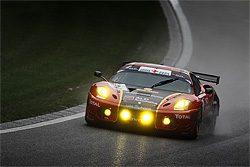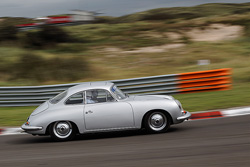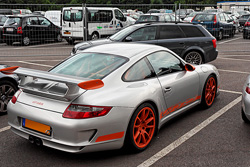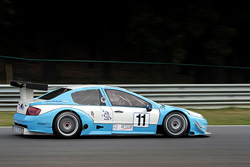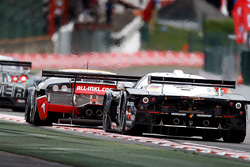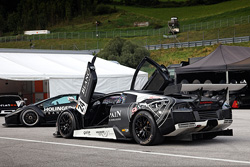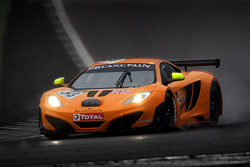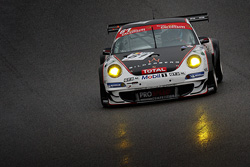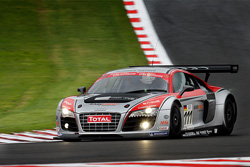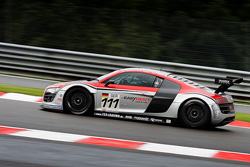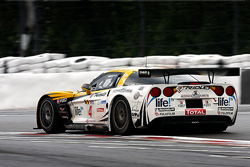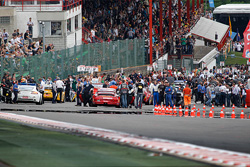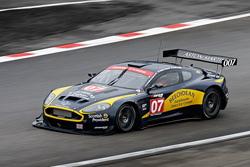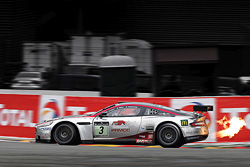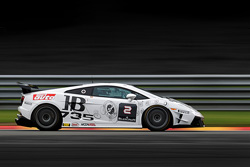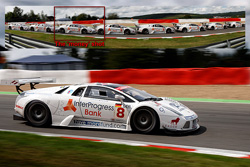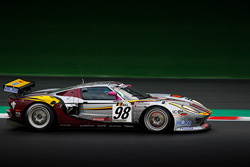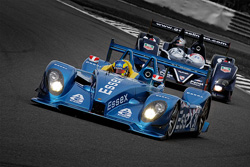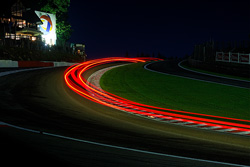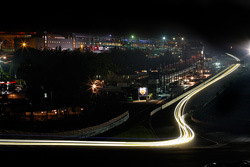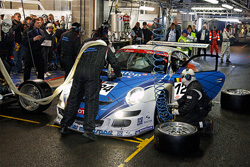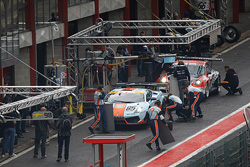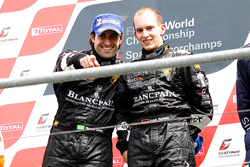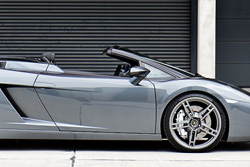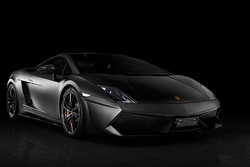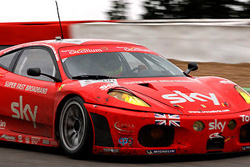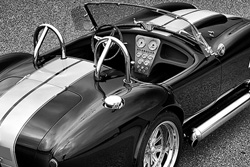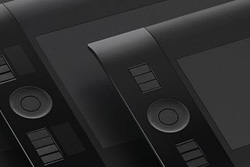PHOTOGRAPHING A MAJOR MOTORSPORT EVENT
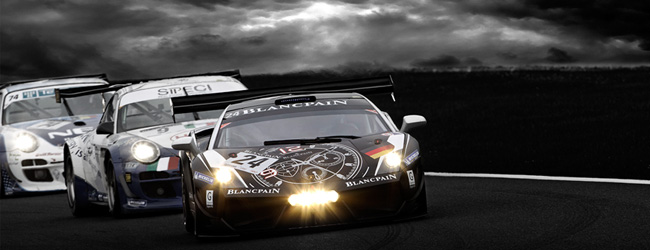
Canon EOS1D Mark IV - Canon EF500mm f/4 L IS - 500mm 1/250 sec f9.0 ISO100
Intermediate level tutorial by Mark
Most aspiring car photographers have a weakness for sports involving cars too, the adrenaline rush of seeing a GT1 or Formula One car thundering down the straight on a circuit isn't easily topped. The feeling you get from walking through a pit lane during an actual championship race can only be described with some carefully taken photographs, words could never capture that and the same goes for the paddock ... usually packed with massive trucks that have been converted into mobile workshops and a hectic workforce who's only brief in life at that moment is to keep the driver on the track in a car that is the fastest during the race.
We've done a Race photography - a day at the track tutorial before, but in that one we focused mostly on how to handle such a day holding an official press pass, and not everybody will be able to obtain such a thing in the beginning, so in this new tutorial we will walk you through some tips to get the best shots from spots available to the general public.
Don't let anyone tell you it is impossible to make extremely good photographs at the races from behind the fence ... I have seen photos from enthusiasts in the crowd that look a million times better than shots taken right next to the track ... it all depends on having a keen eye to spot a photographic opportunity, not on massively expensive equipment ... although I must admit the latter does make it easier, still the Ferrari shot in the rain was taken standing behind the fence, pointing the camera over it in fact.
1. Nothing beats the prepared mind
You can always depend on blind luck while visiting a major motorsport event, but keep in mind you are going to try to make the best photographs possible, and sometimes the perfect shot might be just a matter of luck, but let's try to minimize this unreliable factor to a minimum and prepare your visit as good as possible.
1.1 Visit the track beforehand
A major motorsport event will be listed on the track calendar many months in advance, so you know when you have to be ready for the big day, which also means you can prepare a lot beforehand ... getting to know the circuit is a priority in order to get decent photographs.
These bigger events are usually held on well known race tracks, and that same track will be used throughout the year for much more 'open' events, and that is your window of opportunity ... during classic car events for instance the security is less strict and entry fees are much lower too, hence these are your best option to get to know the layout of the grounds around the track before the high profile motorsport event occurs.
Track days, Public events, Super Car Sunday, Renault Days ... those type of events are held on the paddock and circuit of the same track that will be hosting those GT1, ALMS, LMS or F1 races later on ... during these lower profile events the field marshals don't have to be so strict and most of the time the pit lane is open to the public when the cars aren't driving ... this allows you to look for the best position to get to when the major motorsport event comes into town.
1.2 Planning makes perfect
If you've managed item 1 above correctly you should now have a near perfect grasp on the best public spots around the track, so now it is time to plan the big day when the big league race arrives. One of the advantages of these high profile motorsport events is the fact they have their own website, on which a timetable is published ... so get hold of it as soon as possible to plan your day.
Keep in mind you will not be the only one attending the big race, there could be a huge crowd heading towards the race venue, especially for the main race as most of the time during the major event there will be other series driving too, practice runs, qualifications ... and a lot of entertainment around the circuit. So make sure you're on the parking lot at least an hour before the race you want to cover starts, this will avoid you being trapped in the traffic jam that is bound to be there on the way to the parking lot ... trust me: "been there, done that" ... I arrived late at the track so I had to change my planning and start at a location I didn't really like.
Another advantage of arriving early at the track will be the fact there will be less crowd around so you can position yourself just right behind the fence in front of an opening or on a higher level so you can shoot over the fence altogether, a small stepladder might be a good idea too, I'm rather tall so I can usually 'peek' over most fences, but I've seen many people standing on trash cans and stuff like that ... only to fall over or go through the cover at a certain moment ... hilarious perhaps, but not such a good idea with that expensive camera in hand.
2. Let's talk hardware
We've all seen those professional motorsport photographers walk around with a small fortune in camera bodies and lenses, it might make you feel a bit out of your league among those massive canons, but fear not ... with the right technique on a good location even an old, entry level DSLR with a decent lens will deliver stunning photographs.
2.1 The camera
Take a look at the photo of this Peugeot BTCS race car ... the shot was made with a old Canon EOS350D camera and by going for a position close to the track all it took was a 100mm lens and some panning experience, I'll show you how to get the perfect panning shot down the line so don't worry about that for now.
What you really need to be able to get good photos at a motorsport event without press accreditation is a DSLR camera you've been using a while so you know the settings, it usually isn't a good idea to take on any photography event with a brand new camera you don't now your way around. Also track-side photography with a compact camera isn't the best option, the delay between pressing the shutter and actually taking the shot is too long, the car will have past you by the time your photo is exposed.
2.2 The lens
Depending on what kind of photos you are looking for you'll need a different lens, when trying to get some action shots from cars on the track you'll need some reach, however when you are able to get onto the paddock or even get into the pit walk you will have to use a totally different lens.
2.2.1 The 'long' lens
Perhaps even more important than your camera is the lens you are going to bring along, for any track photography I would advice at least 200mm to be honest, the more the better, unfortunately above 200mm most 'glass' gets expensive very quickly, so work with what you already have ... or rent a longer lens, that isn't too expensive these days either.
I have done the same in the past, rent a Canon EF600mm lens from Wednesday to Monday to cover the 24 hours race at Spa Francorchamps, buying such a specialized lens is too expensive for the use I have for it, so renting it for a few days is a much more economic option, don't forget to look into this too if you want to head to a motorsport event.
2.2.2 The 'short' lens
Your visit of the track during a more 'public' event should have given you an idea on what length you would be needing to photograph the action on the track, and if you get a paddock access during the motorsport event you should bring a more standard lens like a 17-55 on a crop camera or a 24-70 ... something that will allow you to get up close to the action on the paddock area, during a big event there is a lot of action going on, make sure to capture some of it too.
Usually people that are professionally racing cars tend to drive some amazing cars themselves hence it is worth while to wonder around on the paddock so you can capture these exotics, most of the time a spare race car or preparation of the actual car before the race would be done on the paddock before they roll it into the pit box, which is off limits to the public normally.
2.3 Keep it dry
Depending on where the big motorsport event is held you'll have to keep an eye on the weather, I have covered nearly 10 years of the 24h de Spa race in Belgium, and not a single one kept it dry. So packing some kind of rain protection for both yourself and your material in that backpack is probably a very good idea, I know the top of the line cameras and lenses are weatherproof, but I still protect them anyway ... better safe than sorry.
On the other hand taking photos of race cars in the pouring rain might not appeal to you, but the resulting photos are absolutely stunning ... you have the high speed of the car and the mist of water they launch behind them, when taken at the right shutter speed these are one of the best looking motorsport shots ever.
2.4 The 'other' stuff
Please don't forget the basics like memory cards and batteries ... even I tend to forget this sometimes and arrive at a major event with only one memory card. You will need enough space to hold lots of photos as I am going to advice you to use the 'burst' option on your camera ... this will take several shots in sequence while you hold the shutter which is especially useful to get a sharp panning shot as you will read later on. A monopod is also a nice item to take along, it allows you to rest the camera on something from time to time, taking the weight off your shoulders ... that small camera can become very heavy after dangling around your neck for hours, especially if you have a longer lens mounted on it.
3. Capture the action
Once you know the timing for the race you'll have to decide if you are going to stay put or wonder around. Will you be doing your shooting from one location only, or will there be time to take some different angles of the cars coming by ... your decision will depend on the length of the race naturally, for a 24h race like Spa Francorchamps or Le Mans you have all the time in the world, but for races that last only 30 minutes or so you might have to run between shooting locations or just stay put on one good spot... keep that in mind when selecting your initial position.
3.1 Multiple angles from one spot
If you select your position wisely you might be able to get different angles without moving around, for instance at the Belgian Spa Francorchamps circuit you could get a nice spot at the outside of the Raidillon, Eau Rouge at the end of the straight after La Source, the cars are driving fast on that spot and the public has a nice vantage point from there:
3.1.1 Head on:
It is possible to get different shots from the same location, for instance from this position it is possible to capture the cars when they come thundering down the straight and head into Eau Rouge, keep in mind they are going rather fast here and will hit the brakes when they reach the curve, so don't let them fool you here.
3.1.2 Three quarter front:
The same position as before, only waiting a little longer for the car to show the side so you end up with the classic front three quarter view. Note that this angle requires you to use a relatively low shutter speed to keep the wheels spinning and keep the feeling of speed in the photograph.
When doing a full head on shot you can get away with very fast shutter speeds because you don't see the wheels anyway, so the feeling of speed is a bit lost in those shots.
3.1.3 Side panning:
Panning shots aren't the easiest in the book, but they always look amazing ... as long as you keep the shutter speed slow enough to have the wheels spinning and the background blurred ... the feeling of speed just oozes off these shots.
3.1.4 Three quarter rear:
This Corvette passed you already and now you try to capture the rear quarter view, still maintaining a rather slow shutter speed to keep the speed in the shot, and to make things even worse you'll need a lot of reach to capture this angle of the race car as it leaps over the hill passing Kemmel towards Les Combes ...
3.2 The battle shot:
If possible try to get more than one car in the frame when you shoot a motorsport event, showing the actual battle between multiple cars trying to pass each other is probably the next best thing you can capture during a race, it shows just how fierce some drivers get when the race is in the last minutes, especially when first and second place are still undecided ... there is only one shot to top this ... a crash.
3.3 The pit walk
Most events offer a kind of pit walk before the race actually starts, this allows the public to view the cars up close, do keep in mind this is usually an option on your entry pass, and sometimes a rather expensive one too, so don't feel bad if you can't get up close ... you will not be able to get any decent shots anyway, the crowd will be too thick for you to get a nice photograph.
The only real opportunity during a pit walk is the fact you are likely to be able to photograph the drivers up close, and that's a very nice option usually, the cars are amazing but keep in mind it is the pilot that sits behind the steering wheel, so he's equally if not more important to get a shot of.
Variation on your race photography is very important, I know you might be tempted to stay in your spot, but think about your fellow enthusiasts ... they would like to get some decent shots too, so don't stay in the same location for too long, in the end you'll end up with hundreds of photos that all look alike. Even during a 24h race I move around a lot, usually I stay in one location for 15 to 30 minutes and move on.
4. How to ...
The high profile motorsport events always draw a massive crowd, so you might find yourself surrounded by lots of fellow photographers trying to capture that one, elusive shot that could launch their career as a professional, so you will have find a way to make you photos stand out from the rest ... and we'll give you some direction on how to get the best shots.
4.1 shoot over the fence
A high profile race track will have a fence to keep the public away from the track and as a security measure to keep you safe in case of an accident. This has two downsides: for one the fence will be high and in your way to capture the cars on the track and secondly the distance between you and the track could be large so you'll need a long lens.
Fortunately most race tracks these days have noise regulations ... you have to admit those race cars make a lot of noise, and to keep the roar on the track they usually create artificial hills and ridges just behind the fence that encloses the track ... and this is just the right spot for you.
4.1.1 Get some height
Take a look at the high speed shot of the Aston Martin ... it was taken using a 100-400mm lens mounted on an old Canon EOS40D while standing on the hill behind the fence, so I could point the camera over the 2m high fence. It can be done you see, I'm sure being track-side would not have been a plus for this shot as it would have a lower position ... that would show the buildings on the other side of the track ... so in this case it was even better being behind the fence instead of standing in front of it ... it all comes down to selecting the right position.
Another option could be a small stepladder, you know the kind with a few steps usually used in the kitchen ... these are made from aluminum most of the time so they don't weigh too much and can be taken with you. This will also position yourself a little higher to make shots over the fence.
4.1.2 Keep it low
Having a full track/pit lane/paddock Press accreditation is in now way a free ticket to the best photos, if you select your position behind the public fence correctly you can get even better shots than the professional guys with ten thousand Euro worth of equipment just behind the safety wall.
The silver Aston Martin with the flaming exhaust was photographed with a high end camera standing next to the track on the outside of La Source at Spa Francorchamps, and sure it is a nice photo, but take a look at the background ... it took some serious post processing to keep attention on the car and not on the colorful background ... this image tells you one thing: being track-side with full press accreditation might look easier, but getting a perfect motorsport photograph needs skill and a keen eye, no matter where you are around the track.
4.2 get the best panning shots
When you attempt to photograph a major motorsport event you will have to come home with some of those legendary panning shots, showing the side of a race car at speed with a nice background blur and spinning wheels to keep the feeling of speed in your shot.
Unfortunately this is one of the most difficult shots to get right, especially at a slow shutter speed and working with GT1 or F1 cars as these tend to be rather fast, so they enter your viewfinder quickly and only stay in the frame for a few seconds ... getting the car sharp and keeping the wheels nicely blurred is a technique you'll need to master if you want to come home with good looking panning shots that show the speed of the car.
4.2.1 The classic way
Even if the AF (AutoFocus) on your camera or lens isn't fast enough to capture a sharp panning shot at a low shutter speed there is still a way to get a good photograph ... you just have to do it the classic way. You do remember back in the early days there was no AF available, so you had to tackle this in a different way: professional race drivers tend to use the same 'line' on the track every single round, so you take advantage of this by selecting a point in front of you where you know the car will be passing ... focus on that point, switch to manual focus and wait.
When the car comes into view you point your camera to it and wait until it reaches the spot you've put your focus on earlier, press the shutter ... and you end up with a sharp image of a passing car, nicely blurred background and spinning wheels (you did remember to keep the shutter speed slow right?) ... most of the time.
4.2.2 The easy way
One way to get a good panning shot is the 'burst' mode on your camera. This specific mode allows you to take several photos in a row, as long as you keep the shutter button pressed you will be taking subsequent shots ... until the buffer fills up, but still you'll end up with 8 or 10 shots of the car passing you ... it would really be bad luck if none of these would be sharp with nicely spinning wheels.
With this method you point the camera towards the direction the car will be heading towards you, when you see the car in the viewfinder you press the shutter halfway until the AF kicks in, then you press it all the way down and keep the shutter pressed while you swing the camera from side to side while the car passes, trying to keep the latter nicely within the frame ... if you decide the race car is going too far away from you just let go of the shutter ... you'll probably have to wait a second or so for the buffer to be written onto the memory card, but you'll end up with a series of shots from which you select the best one at home.
4.2.3 My way
I started with DSLR photography when AF was readily available, so I tend to use it for my panning shots and don't work with the manual focus on one specific point. After some practice you should be able to get to grips with fast cars and slow shutter speeds ... this Ford GT was driving fast when it hit the brakes ahead of a corner, so the front disc brakes heat up, dialing in a 1/80 shutter kept the wheels spinning very nicely and the car still tack sharp ... a perfect panning shot.
I usually only take one shot during a panning swing these days but I have to admit I did use the first option in the beginning ... just burst the panning swing and select one of the shots as the best one, deleting the rest ... but if you put some practice into it, attend a few other events with slower driving cars to get experienced and I'm sure you'll be making slow shutter shots quickly.
4.2.4 Side panning shot ... step by step
I guess you will not be using the classic, manual focus method to begin with, so let me talk you through a side panning shot step by step:
Step 1 Select you position The easiest way to get a good panning shot is to be in a position along the track where the cars are traveling at a constant speed and you see them coming way in advance and have the space to 'follow' them after they pass you.
Step 2 Settings Put the camera in shutter priority and dial in a shutter speed of 1/250 to begin with, later on drop it to about 1/40 depending on the speed the cars pass you. If you have an IS lens make sure to put it in 'horizontal' mode only (on a Canon that would be mode 2) so the image stabilization only corrects vertical movement and not the horizontal 'swing'.
Step 3 The panning swing When you see the car approaching through the viewfinder you press the shutter halfway so the camera's Auto Focus kicks in, keep tracking the car until just before it would be dead center in front of you and press the shutter all the way down and release it but continue to follow the car as it passes.
Using this technique will have the car in full side view directly in front of your lens when the photo is actually exposed, by continuing to 'swing' while you release the shutter the car will be sharp in the shot, of you would stop this swing when you release the shutter you might have a blurry image instead.
I usually start out with a shutter speed of 1/250 or 1/320 to get the shots I really need, once those are done I change to 1/160, 1/80 and even 1/40 to get that very smooth blur in the shots, the only problem will be not all your photos will be good enough to publish, so make sure you start to experiment with slower shutter speeds after you've got the shots that matter at a higher speed.
5. Final pointers
A lot of action is going on during a major motorsport event, not only on the track but also around the circuit grounds, and a massive crowd is probably present so think about securing your material a bit, never leave a backpack open or unattended while you are photographing the cars, equipment is expensive and not everybody is honest when a large number of people are packed together.
5.1 Your safety
I've said it before and I'll keep repeating it, make sure you select your position around the track with care, you'll want a nice, clear view of the action ... but keep in mind some spots are more dangerous than others, this is a high paced action sports and accidents can happen so never position yourself in a spot one of those race cars can end up when they miss the corner or loose traction.
5.2 The 'other' photos
I know those panning shots are amazing, but trust me, after a while they tend to get a bit boring, so you start to look for variety in your photographs, so let's take a look at some of the 'other' shots you might try to get at a major motorsport event.
5.2.1 Long shutter night shot
One of the easiest shots to make during a 24 hour race is the night shot with a long exposure, the result are beautiful streaks of light as your exposure will take longer than the cars that pass, hence their taillights 'draw' red glowing lines in the shot while the headlights shine a bit on the dark track.
The only thing you have to bring with you is the tripod because you will need to keep the camera perfectly still for about 10 seconds or so ... now I don't know about you, but I can't keep my camera still for that long, so a nice tripod is the most important option in this case.
Try to get a nice overview shot while you are photographing, this night shot of Spa Francorchamps during the annual 24h de Spa shows the paddock, the pit lane, the track with the cars passing ... but what is more important is the fact the 'viewer' gets a very nice feeling of the atmosphere surrounding such a high level event.
5.2.2 Pit lane action
Pit lane action is always impressive during a race, unfortunately you will need proper accreditation to get this kind of shots, most likely even wearing fireproof clothing at the more important events ... but there is one way to get this kind of shot without full press accreditation.
Naturally at your own risk, but most of the time there are preparation days before the actual race weekend, for instance for the Spa 24 Hours in Belgium the fun starts on Wednesday already, while the actual race doesn't start until 4pm on Saturday.
And this is your window of opportunity ... during the race or the qualification rounds you will not be able to get into the pit lane due to the security marshals, but on the days before the weekend the teams will be training themselves to change tires and re-fuel ... and that is the time you are able to get some nice photos of the action without press accreditation ... just don't get in the way of the engineers on the team.
If getting into the pit lane is not an option there is a second possibility to come home with some very nice action shots ... a long lens.
This shot was taken with a 600mm lens, but from a different angle you could get away with 200mm or 300mm and still capture the action from the team on the car ... even during the race, it all comes down to getting the right location to take your photograph from ... so it might be a challenge, but it it surely isn't impossible to get pit lane shots as a member of the general public.
5.2.3 The champion
If you get to the opposite side of the track in front of the podium you will actually be able to photograph the winners of the race.
Again it will take some reach so a long lens is a must in this case, but while most of the official press accredited photographers are on the track or at ground level, you can use the grandstands to get a higher vantage point ... and possibly even get a better shot of the racers that took the checkered flag first.
5.2 Final thoughts
If you've taken a look at the exif data in the photos listed in this tutorial you'll probably noticed I specifically used shots from different cameras, ranging from my first Canon EOS350D over the EOS40D right up to the EOS5D MarkII and the impressive EOS1D MarkIV with the stupendously expensive 600mm lens (which I rented by the way) ... just to show you it isn't the equipment that results in great shots from a motorsport event.
So my final piece of advice would be ... to have fun, get some experience at the smaller motorsport events before going onto the big ones ... but the most important thing is to be careful ... motorsport racing is fast paced and accidents do happen, keep that in mind when you decide on a position to take your photos from.
 |
CPT Premium member BONUS : 74804 Become a CPT Premium member to download eBook on this tutorial as an easy to read and printable PDF document. |
Note : commercial use or publishing of our tutorials in any way, written or electronic, is strictly forbidden, we present these for your personal development only. None of our material may be published in any way without prior, written permission from the Car Photography Tutorials founder. All workflows and photographs are copyright protected and owned by the Car Photography Tutorials team unless stated otherwise
Advertisement
Become a MEMBER
Premium Membership
Become a CPT Premium Member and download all our tutorials including a PDF for printing and the result as a PSD file with layers if any.
Interesting articles
Your second shopping list
You have all the basic equipment, and you feel comfortable working with it ... now it's time to take your gear to the next level.
Creating a photo from a showroom snapshot
Sometimes you just don't have the option of setting up a nice area for a shoot, for instance when you are in a showroom, but fear not, we show you how to make a photograph out of a snapshot in post processing
Make panning shots like a pro
We all made these mistakes at first, but after gathering some more experience we could pinpoint these mistakes and share them with you so you can avoid them.
Black and white car photography and selective coloring
We take a look at how you can achieve the best results converting car shots into black and white one, we even take a look at selective coloring to put some color back into the image.
Use a mouse or a tablet for post processing
Perhaps a mouse isn't the most appropriate option when working on automotive photos in post processing, so let's take a look at a pen and tablet.
